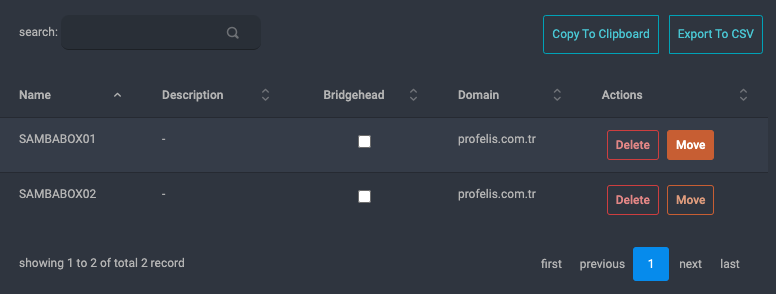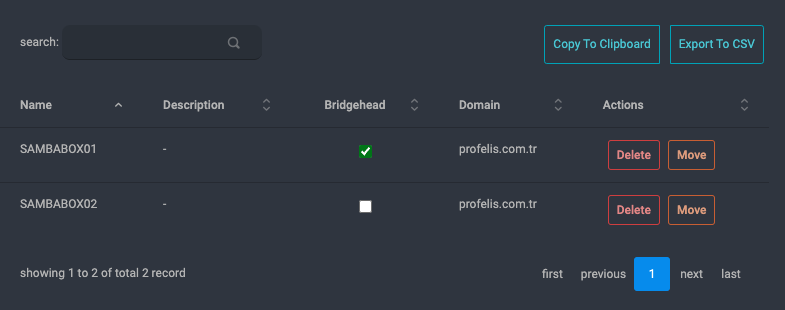Manage Servers
These servers are the heart of an SambaBox Directory infrastructure. They store a copy of the directory database, including user accounts, group policies, and security settings. Domain controllers handle user authentication and authorization, ensuring secure access to network resources.
After you join a new SambaBox to your domain by following stes in migrate page joined server will appear in the servers container of the selected site in migration steps.
Move server to another site

Delete server from directory
Be careful because this option deletes the domain controller completely from directory

Make a server bridgehead

In SambaBox, a bridgehead server is a critical component responsible for facilitating the replication of directory data between different sites in a distributed network environment. It acts as a synchronization point between domain controllers in separate SambaBox sites, ensuring that changes made to directory objects in one site are efficiently and accurately replicated to other sites.
Bridgehead servers play a crucial role in maintaining the consistency and integrity of SambaBox directory data across geographically dispersed locations. They determine when and how replication should occur, optimizing the use of network resources and reducing replication traffic.
Hint
Key points to understand about bridgehead servers:
In SambaBox, a bridgehead server is a critical component responsible for facilitating the replication of directory data between different sites in a distributed network environment. It acts as a synchronization point between domain controllers in separate SambaBox sites, ensuring that changes made to directory objects in one site are efficiently and accurately replicated to other sites.
Bridgehead servers play a crucial role in maintaining the consistency and integrity of SambaBox directory data across geographically dispersed locations. They determine when and how replication should occur, optimizing the use of network resources and reducing replication traffic.
Key points to understand about bridgehead servers:
Replication Control: Bridgehead servers control the flow of replication traffic between sites. They determine which domain controllers should replicate changes and when, based on a cost-based algorithm that considers site links’ bandwidth and schedule.
Optimization: By selecting the most appropriate path for replication, bridgehead servers help reduce unnecessary network congestion and latency, ensuring efficient data synchronization.
Fault Tolerance: Having multiple bridgehead servers within a site provides fault tolerance. If one bridgehead server becomes unavailable, another can take over replication responsibilities.
Security: Bridgehead servers use a secure channel for replication, helping to protect sensitive directory data during transit.
Site Links: They work in conjunction with site links, which define the connectivity and replication schedule between SambaBox sites.
In summary, bridgehead servers are a vital part of SambaBox’s replication mechanism, ensuring that directory changes are propagated accurately and efficiently across a network of multiple sites while considering network conditions and bandwidth constraints. Their proper configuration and management are essential for maintaining a healthy and responsive SambaBox infrastructure in large and geographically dispersed organizations.